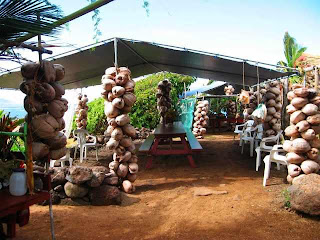When we started our Best Hawaii Vacation blog, we told everybody that this is our way to share our love with Hawaii and the Hawaiian people. Without their aloha spirit and the endless beauty of the Hawaiian islands, their home, there would not a 'best Hawaii vacation' possible! We owe the Hawaiians gratitude and respect and love. The least we can do, is learn and educate ourselves about their ancient traditions and cultures and help support to maintain their connection between the people and their land (aina). This is what this Hawaii blog post is about.
Jennifer Smith from the Molokai Dispatch interviewed Leimana Raymond Naki, Molokai fishpond caretaker, and Petra Wegman from Aloha Coaching, one of his strongest supporters.
FISHING FOR THE FUTURE with Leimana Raymond Naki
For centuries, ancient Hawaiians looked to the fishponds, LOKO I´A, for nourishment and livelihood. Today, groups throughout the islands are engaged with their ancient knowledge to revive this food source. Molokai alone hosts over 60 FISHPONDs, which are amongst Hawaii’s greatest engineering achievements. The semi-circular walls of the ponds are meant to keep fish in, while allowing seawater to circulate. Natural occurrences and lacking care in ongoing years have caused KAHINA POHAKU and likewise other fishponds to fall into a state of disrepair.

The caretaker Leimana Raymond Naki, his family and many others know how important it is to use resources of the island and they invest continuously time and hard work. They'd like to do more than only repair the walls of the ponds. The restoration effort involves such things as educating the island's youth, creating culture-based experiences, supporting responsible tourism, and promoting sustainability. While the ponds never produce the abundance of fish they once did, community support is redefining Molokai's LOKO I'A as epicenter for education, culture, and fellowship.
KAHINA POHAKU
While not the biggest fishpond on the island, Kahina Pohaku is certainly one of the most visible. The four-acre fishpond is located at the 19-and-a-half mile marker on the East End of Molokai. Most drivers could recognize the pond from the highway by its outrigger canoe, surrounding coconut shacks, the "oceanic classroom" and breathtaking view of Maui. Literally translated, Kahina Pohaku means Hina’s Rock; in Hawaiian culture HINA is regarded as the mother of Molokai.

Leimana Raymond Naki, says that the pond has a deeper physical and spiritual meaning. "It is a place where the rocks support each other," under the water and above the water. Naki has been involved with the pond for nearly a decade, including the last three years which he has dedicated to living there full-time. According to Naki, he and his `OHANA/ family gave up the comforts of electricity and running water to care-take the area and ensure its revitalization.
And for the past two and a half years Naki has also enjoyed the help of a dedicated German, Petra Gabriele Wegmann, who is here half of the year, to support the construction with great dedication. Petra Gabriele Wegmann helps Naki to run the workshops, and teach the importance of revitalizing Kahina Pohaku. She says: "I see the importance of the purpose and the meaning of this place. And the transmission of my family friend and mentor Leimana is not to get paid and then do his work - his purpose is to perpetuate the culture, to join the old knowledge with today’s thinking."
While getting the walls back up is Plan A for Naki, he has also worked very hard to support the pond and his culture through Plan B: education which is the key for the future, as he says. For this he regularly holds workshops at Kahina Pohaku for local children, clubs, tourists and interested people from the whole world. He provides workshops on everything from traditional ways of laying net, to HULA, music, and MO'OLELO. Feeling passionate about the fishponds ability to educate children in ways that traditional classrooms cannot, the teaching duo encourages teachers to bring their students to the pond. "My classroom is round and it is an open space, they are not confined here," Naki says. Having never seen kids "so happy," Wegmann said many don’t want to leave at the end of the day. "They can’t believe it’s really a school class."

"Revitalization and restoration are part of the whole", Naki says explaining that, what has to be done for the ponds, is not just a “project". "By having Kahina Pohaku it gives pride in our culture," he says. “Our ancestors, our enemies, our neighbors ate from here.” However, today Naki said the fishpond is hurting. Because of this, today our family does not fish from Kahina Pohaku. The broken walls aren’t regenerated yet and the fish population also isn’t replenished. "When the walls go up, the fish goes in," says Naki. And it is with this belief that he continues trying to find the means to let this happen. "It would take several months for a dedicated group of hard workers to get the wall back up", Naki says. He is looking for grants and possibilities that would allow him to pay workers and material.
Perpetuating KAHINA POHAKU
Leimana: "Whether it’s a fishpond or a taro patch, it is a way for the people to connect back to their culture. It is like starting over - it’s going to be hard, but we gonna make it. There will be fish - fish to provide for community and our families. What we have here is real, the resources are real."

Further information about KAHINA POHAKU, Molokai and the possibilities for you to take part or contribute, please contact Petra Gabriele Wegmann, who is staying in Germany right now and will return soon to Molokai, Kahina Pohaku and her family Naki. You can reach Petra by email. You may find the original full interview 'Fishing for the Future' at 'The Molokai Dispatch'
Our mahalo goes to Petra, Leimana and Jennifer for this great article. Hawaiian Fishponds are not only a means to make use of the fish resources, but places of the utmost serenity and peace, as the photo below shows. Aloha, Pua Hawaii Vacations
p.s.
When you are still looking for the best place to stay in Hawaii for Thanksgiving, you might just find it on our post Best Hawaii places Thanksgiving 2008.

Hawaiian Culture Related Articles
Best Big Island Luau
Tags:



No comments:
Post a Comment